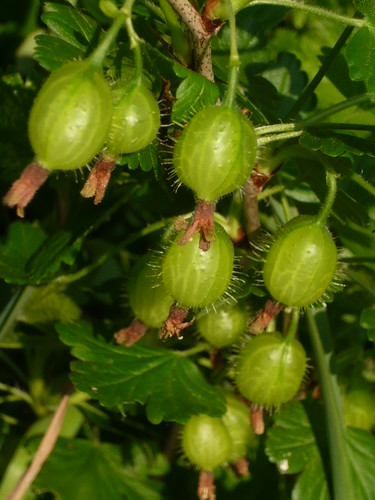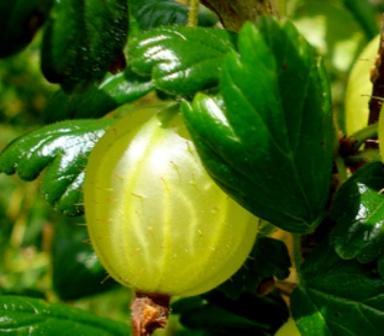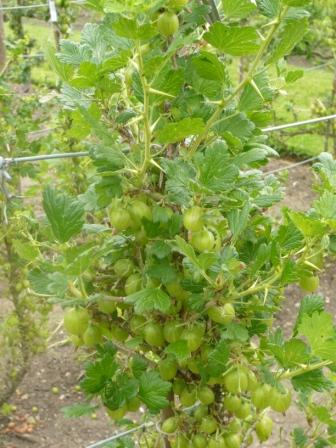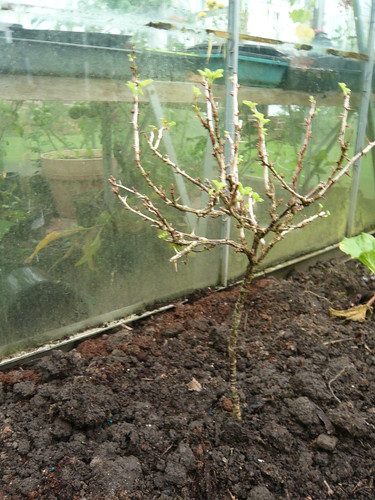Remarkable Gooseberry Crops Again
Five years ago I wrote about my remarkable gooseberry crop and yet again I have been inundated with great berries this year (2019). ‘Sweet or, sharp and sour the gooseberry is a remarkable soft fruit. Summer 2014 was been a remarkable year for the size of my crop and the freezer was bulging (like my waist from numerous crumbles).’

Gooseberry Summary Top Tips
- Plants prefer a cool climate and will withstand a windy position with light well drained soil.
- Do not feed excessive nitrogen which encourages mildew.
- Water with a liquid feed as the fruit start to set – this increases berry size and limits splitting.
- Fruit appear on new and old wood so aim for a balance between the two.
- Varieties are classified by the colour of the fruit as Red, Green, White and Yellow. At home you may want a mix of kinds.
Gooseberry Calendar
- Bushes fruit in June and/or July
- Take cuttings in September,
- Prune cordon shoots in March but reshape and reinvigorate by pruning in winter.
- Plant new bushes in November or March if the soil is very heavy.
- Varieties come in early, mid season and late (examples Early Sulphur, Gunner, Lancer)
What a grand way to grow Gooseberries ‘up a stick’ (or Cordon).  Trained like ballerina apples this Gooseberry variety London was grown as one vertical trunk. Gooseberry London has very large oval fruit with a smooth skin. The flavour is good and is normally a spreading bush but it makes few branches. It is renown as heavy yielding as can be seen below from a 1st June photo below.
Planting Layout for Legs or Cordons
- Two rows one meter apart were created by 3 very stout posts 4’6″ above the ground and a similar distance apart. Vine wire was strung between the posts to create a rigid support.
- Two cordon plants supported by their own cane were placed between each post (4 per row).
- The Gooseberries grew 5-6 feet tall and were pruned to have only one main vertical stem. Other growth is pruned out in March to channel energy into fruiting.
- Despite some Saw Fly damage the quantity and quality of fruit was exceptional.
- Double cordons can also be grown in a similar manner
This style of growing makes picking much easier as there is little bending and there are far fewer prickles to get under your skin (or tear it to shreds for that matter). My Gooseberries grown as sprawling bushes are giving a good crop this year but I like the economy of space and the benefits of this training system so I will give it a try.
Gooseberry Tips
- Gooseberries are tolerant of cold windy weather and poor growing conditions but dislike shallow chalky soil.
- Too much nitrogen feed makes gooseberries prone to mildew attack but a manure water feed will help fruit to swell and prevent cracking.
- November planting is advisable as fruiting is early in the season but if the soil is too heavy and not well drained March planting will suffice.
- Gooseberries enjoy partial shade and can be used as a windbreak so they are doubly useful fruit trees to grow.
- For something a bit different try growing Gooseberry Langley Gage with a small transparent berry of exceptional sweetness.
- Sawfly can be a problem eating all the leaves within a week. Pick off as soon as you see them or use an insecticide.
- Some varieties are more prone to mildew. Prune to have an open shape to let in air or grow a resistant variety
- Gooseberry shrubs can be raised from new wood cuttings 6-10″ in length. September is the recommended time but I seem to get cuttings even from summer prunings.

Gooseberries are fine soft fruit and in line with my plan to grow more fruit I have just bought a new shrub of the Invicata variety. It is said to have large green fruits and be mildew resistant. I will test the mildew resistance to the limits as I threw out 4 large bushes some years ago because they were perennially invested with mildew and a resulting black deposit on the fruit. My local nursery wil not have any other varieties on offer until March when I may buy some more shrubs but as each plant will produce about 3 pounds of fruit I will already get enough for pies, fools and freezing.
More Cultivation Tips
- Prune in spring by cutting back leading shoots by about one third. Aim to have an open centre to allow air to circulate and make picking easier.
- Use prunings to root new plants – they root quite easily but take a couple of years to fruit.
- Feed 2oz. of Potash fertilizer at the end of February. Avoid an excess of nitrogen fertilizer as in makes soft growth prone to mildew .
- Mulch around the shrubs and protect from tits and finches if they nip out new shoots.
- Each bush should be 4-5 feet apart. If growing as cordon they can be as close as 1 foot apart.
- Gooseberries can be trained as half standards or with legs like the photo.
- Other varieties to try include Keepsake, Early Sulphur, May Duke, Hinnomaki Green, Green Gem, Jubilee, Careless, Leveller and Lancashire Lad
- Try the dessert varieties Pax, Rockula or Whinnams Industry
- A good supplier of Gooseberry bushes is Chris Bowers



6 thoughts on “Remarkable Gooseberry Crops Again”
I will share this with my dad — he will be very excited! Thanks!
Hello,
I would like to grow Invicta Gooseberies as cordons. There is lots of advice about how far apart and when to plant them but WHERE DO I FIND THEM?? !!
There are plenty of bush plants available but NOWHERE can I find cordons for sale!
Can you advise please?
Kind regards
I hope your ‘waste’ has shown signs of improvement.
Comments are closed.